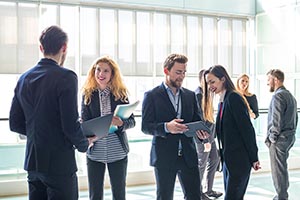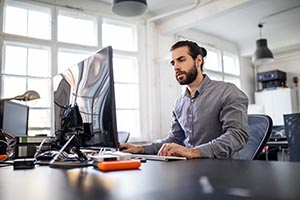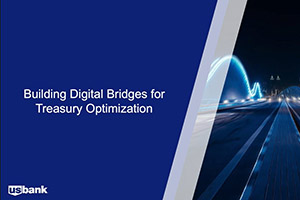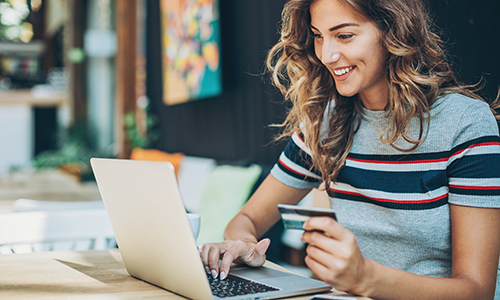Discover which new ventures will dominate the sector in the next several years.
We’ve been following new technologies in the banking industry for many years, watching them disrupt long-established processes. Predictably, every new device linked to the internet represents another venue for customer interaction — and another potential headache for IT and security departments.
The pace won’t slow down, so it’s crucial to understand these new technologies and trends and integrate them when it best serves your business. At U.S. Bank, we’re convinced that digital integration at the right time is akin to building a bridge along a strategic path. A Digital Bridge.
Digital innovation: key focus areas
The digital innovation team at U.S. Bank has identified, and continues to pursue, the following areas as top priorities:
- Digital identity
- Big data + predictive analytics
- Blockchain/Distributed Ledger Technology (DLT)
- Developer portals and application program interface (API)
- Location-based services
- Internet of Things (IoT)
- Artificial intelligence (AI), machine learning, Robotic Process Automation (RPA)
- Biometrics
- Customer experience
Each of these areas varies in maturity, though all have the potential to shake up banking systems. Many already do, thanks to increased consumer adoption of smart devices for transactional management.
We don’t take for granted that every company is different, and not every technology will optimize operations at any given time. Instead of this “all or nothing” approach, we know that partnering (vs. directing) for innovation is the best way to design and build the digital bridge that your business needs, when you need it.
Still, there are a few concepts in innovation that characterize many business’ stages in their digital journey. By listening to our clients over the years, and continuously analyzing industry research, we’re confident that some of the biggest, fastest gains are made with three solution sets:
- Workstation + ERP Integration via API
- Blockchain + digital records and reporting
- Artificial Intelligence
These three alone give businesses immense potential with their customers – though only when implemented effectively within their current infrastructures.
APIs and open banking
Jim Marous, from The Financial Brand, said it best: open banking APIs offer potential “far beyond traditional banking, including all of the services a consumer may want in a digital world.”
Banks and businesses have used APIs for years, though primarily through private networks or with formal third-party partners. The open banking trend is causing banks to align with third parties that weren’t formal partners just a few years ago — specifically: financial technology startups. We’ve spoken about the complex, yet productive, relationships between banks and these firms before, but the past few years have shown that persistence has paid off. We now know that APIs enable better business – from customers, through the front to the back office, and higher-order economics.
How do APIs improve business? In general, API development allows organizations to:
- Enable connectivity with other systems, and integration into a larger data environment
- Simplify development, allowing for more customization
- Broaden integrations with legacy systems
- Pursue new distribution channels
- Generate new customer insights
- Maintain (and sometimes improve) customer privacy and security
More specifically, banks and their customers can use APIs for everything from payment instructions, accounting system integration, to issuing rebate cards. Even the age-old system of check printing can receive a boost from open APIs.
It’s why we’ve taken a leading role as financial services companies begin to realize the benefit of Open Banking, driving change with an approach that is progressive, innovative and customer focused. For example, we invested in and were the first bank to integrate with the Akoya Data Access Network.
Blockchain and beyond: distributed ledger graduates beyond Bitcoin
Distributed ledger can improve speed and visibility by removing intermediaries from the transactional process. Since there’s no central clearing house within a ledger, the network itself decides whether or not to approve transactions. How this happens varies by network type, a good topic for a future discussion.
They provide a universally accepted, unchangeable and cryptographically secured record of all transactions and events. Blockchain and Bitcoin brought this technology to the forefront, but banks now use versions of it to keep record of more regulated transactions.
To briefly conceive the benefit of DLT for nearly any business, consider the extraordinarily common operation of procurement, where distributed ledger could be used to simplify the contract process. Organizations can develop “smart contracts” that use distributed ledger for data verification and automatic enforcements:
- Data driven verification: Data are verifiable and the contract terms are known within the ledger record, and all parties can view proof of performance.
- Automated enforcement: If desired, contracts can execute when conditions are met, eliminating reliance on other parties.
- Data are securely stored and auditable in a ledger: Immutable nature of ledger provides transparency from beginning to end (to those with permission to view it).
Distributed ledger now stretches to multiple aspects of modern banking, including capital markets and trade financing. Banks and organizations will need to determine the best ways for their business and customers to adopt this emerging technology.
Machine learning and AI: More than just an Echo
When my team works with artificial intelligence to improve business and banking, we always start with the “biggest picture.” We know AI is sourced from the ever-expanding catalogue of computer science innovations. Because of that, AI has been dreamed of, explained, and applied to an incredible number of moments in a person’s day. For example:
- Virtual personal assistants: Amazon Echo, Google Home, Apple Siri – not to mention our own Smart Assistant in the U.S. Bank Mobile App.
- Natural language processing: The ability for a computer to understand human spoken language
- Computer vision: How computers can gain information from digital images or videos
- Machine learning: How computers can learn to act without being programmed
- Recommendation engines: Predict relevant user behavior based on past actions (of a user, or other cohorts)
- Advanced + Robotic process automation: Tools to further automate industrial and business processes within a central system
Banks have generally limited their AI activities within specific domains or industry verticals. As data rapidly increases and computers perform more computational tasks than ever before, U.S. Bank will continue to elevate these tools for even more widespread use.
The technology will only get better
These three areas represent a small segment of the innovation space, but are making big impacts for businesses along the digital journey. And deeper within these few topics, and of all the big trends I mentioned above, new advancements are developed every day. Not every innovation will work for every organization, nor should organizations jump to adapt when something new arrives. Optimization is not a leap of faith – it’s a strategic decision to traverse a digital bridge, which is crucial to understanding the potential of any innovation, because the pace of disruption will never slow down.
Explore the Digital Bridge: Download our e-book
If you're interested in learning more about these technologies, or if you are looking to integrate them into your broader business strategy, contact us for more information.




















































































